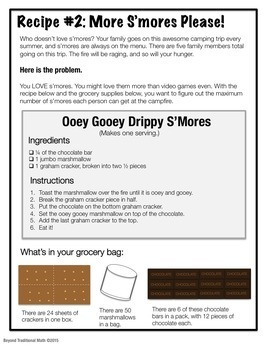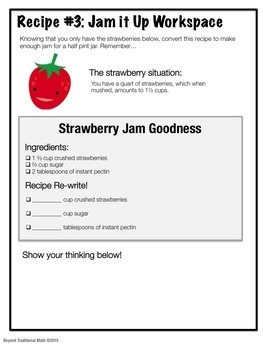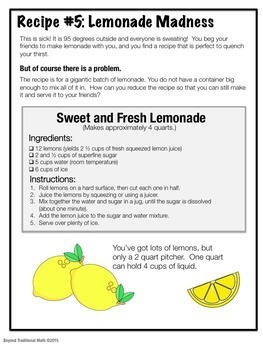Equivalent Fractions in the Real World - Fun Enrichment Activity for Students
- PDF
What educators are saying
Description
Fractions (and especially fraction equivalence) are always so abstract, until you connect them to the real world -like cooking! This is such a fun way to explore equivalent fractions. This resource will help students think critically about equivalent fractions.
Recipe Disasters will strengthen your student's skills with benchmark and equivalent fractions with real world problem solving! Students are given a problem page with lots of reading that includes a recipe, and then a problem to solve. This is especially perfect for allowing students to explore the abstract concept of fractions with a real world setting.
Students need to use benchmark fractions (one half, one quarter) and equivalence to successfully make each recipe. The recipes each have a unique problem for the students to figure out:
Included in this resource:
Each of the 5 recipes come with a page long sheet to read with the recipe and other information, a page for the student to show their work, and a teacher information/key page.
1. Anti-Brain Drain Power Bars: Doubling the recipe for your class.
2. Ooey Gooey S'mores: Figuring out how many s'mores a family of five will get with given ingredients.
3. Strawberry Jam Goodness: Converting the recipe when given a small amount of strawberries.
4. Sweet Crunch for the Trail Mix: Making a recipe using only a 1/4 cup to make the recipe.
5. Sweet and Fresh Lemonade: Figuring out whether to half or quarter the recipe.
These problems can be solved without making the recipe, or if you are brave you can give them a spin in the classroom. They are all no bake recipes (except for the s'mores would require a microwave). All of the recipes are kid tested, kid friendly and especially kid tasty!
You can use this in your class as a(an):
1. Whole class activity
2. Fast finisher activity
3. Small group work at your teacher table
4. Homework for students
5. Gifted and talented small groups
6. Center activity
Common Core State Standard alignment is included. The work is appropriate for students just learning about benchmark fractions of one half and one quarter, as well as for exploring equivalence. The problems are appropriate for 3rd graders, and for 4th graders that might be struggling with these concepts.





